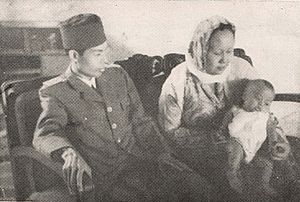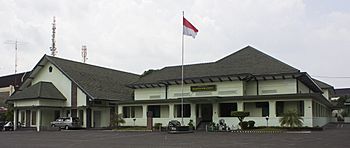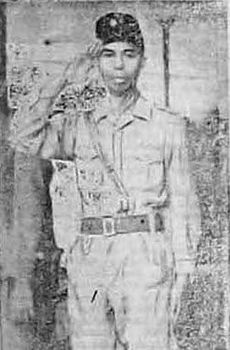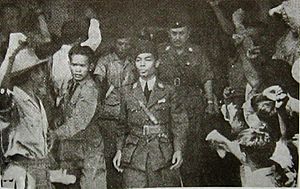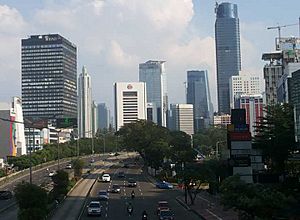Sudirman facts for kids
Quick facts for kids
General of the Army Raden
Sudirman
|
|
|---|---|
 |
|
| Born | 24 January 1916 Purbalingga, Dutch East Indies |
| Died | 29 January 1950 (aged 34) Magelang, Central Java, Indonesia |
| Buried |
Semaki Heroes' Cemetery
(07°48′10″S 110°23′02″E / 7.80278°S 110.38389°E) |
| Allegiance |
|
| Years of service | 1944–1950 |
| Rank |
|
| Commands held |
|
| Battles/wars |
|
| Awards | National Hero of Indonesia |
| Signature | |
Sudirman (born 24 January 1916 – died 29 January 1950) was a very important Indonesian military leader during the Indonesian National Revolution. He was the first commander of the Indonesian armed forces. Even today, he is highly respected across the country.
Sudirman was born in Purbalingga, which was then part of the Dutch East Indies. He moved to Cilacap in 1916 and was raised by his uncle. He was a hardworking student at a school run by Muhammadiyah, an Islamic organization. He became well-known in his community for his strong faith.
After leaving teacher's college, he became a teacher in 1936. Later, he became a headmaster at a Muhammadiyah elementary school. When Japan took over Indonesia in 1942, Sudirman continued teaching. In 1944, he joined the Japanese-supported Defenders of the Homeland (PETA) as a battalion commander in Banyumas. He even helped stop a rebellion by other soldiers, but was later held in Bogor.
After Indonesia declared its independence on 17 August 1945, Sudirman escaped and went to Jakarta to meet President Sukarno. He was asked to manage the surrender of Japanese soldiers in Banyumas. There, he created a division of the People's Safety Body. On 12 November 1945, Sudirman was chosen as the military's commander-in-chief in Yogyakarta. He won by a close vote against Oerip Soemohardjo.
While waiting for his appointment to be confirmed, Sudirman ordered an attack on British and Dutch forces in Ambarawa. This battle and the British withdrawal made Sudirman very popular. He was officially confirmed as commander on 18 December.
Over the next three years, Sudirman saw peace talks with the Dutch fail. He was involved in drafting the Linggadjati Agreement and later the Renville Agreement. He also faced problems within Indonesia, like a coup d'état attempt in 1948. He believed these challenges made his tuberculosis worse. In November 1948, his right lung collapsed.
On 19 December 1948, the Dutch attacked the capital, Yogyakarta. Sudirman, who had just left the hospital, escaped with a small group of soldiers. They set up their headquarters near Mount Lawu. From there, Sudirman led military actions across Java, including a major show of force in Yogyakarta on 1 March 1949. When the Dutch started to leave, Sudirman was called back to Yogyakarta in July 1949. He was told not to fight anymore. In late 1949, his tuberculosis returned. He moved to Magelang, where he died just over a month after the Dutch officially recognized Indonesia's independence. He is buried at Semaki Heroes' Cemetery in Yogyakarta.
Sudirman's death was a sad event for all of Indonesia. Flags were flown at half-mast, and thousands of people came to see his funeral. He is still highly respected today. His guerrilla campaign helped build the army's strong team spirit. Indonesian military students must follow the 100-kilometer route he took before they can graduate. Sudirman's picture was on Indonesian money in 1968. Many streets, museums, and monuments are named after him. On 10 December 1964, he was declared a National Hero of Indonesia.
Contents
Sudirman's Early Life and Education
Sudirman was born in Rembang, Purbalingga, in 1916. His parents were Karsid Kartawiraji and Siyem. He was adopted by his uncle, Cokrosunaryo, who was a sub-district head. This meant Sudirman was given the title Raden, which was for Javanese noble families. However, he didn't know he was adopted until he was eighteen.
When his uncle retired in late 1916, Sudirman moved with the family to Manggisan, Cilacap. His birth father died when Sudirman was six. After that, his mother left him and his brother with his uncle.
Sudirman learned about the ways of both noble families (priyayi) and common people (wong cilik). He also studied Islam with Kyai Hajji Qahar. Sudirman was a very religious child and always prayed on time. He was even trusted to make the calls to prayer.
When he was seven, Sudirman went to a school for native Indonesians. He was an average student. His family was not rich, but they had enough to live comfortably.
Schooling and Nationalism
In his fifth year of school, Sudirman wanted to leave because he was teased at the government school. He later transferred to a junior high school run by Taman Siswa. When that school closed, he moved to Wirotomo Junior High School. Many teachers at Wirotomo were Indonesian nationalists. This influenced Sudirman's views about the Dutch rulers.
Sudirman was a very dedicated student. He was good at math, science, and writing in both Dutch and Indonesian. He also became more religious under his teacher Raden Mohamad Kholil. His classmates even called him "hajji" because he prayed so much. Sudirman also preached to other students. Besides studying and religious activities, he played in the school's musical group and on the football team as a defender.
When his step-father died in 1934, his family became poor. But Sudirman was allowed to finish school without paying. By age 19, he was a student teacher at Wirotomo.
Joining Muhammadiyah Youth
While at Wirotomo, Sudirman was part of the Wirotomo Student Union, drama club, and band. He helped start a local group of Hizboel Wathan, which was like the Boy Scouts. This group was run by the Islamic organization Muhammadiyah. Sudirman became the leader of the Cilacap group. He made sure they focused on religious studies and attended Muhammadiyah meetings. He taught younger members about Islam and good morals. With older members, he taught them strict discipline, almost like military training.
Sudirman as a Teacher
After graduating, Sudirman spent a year at a teacher's college in Surakarta. He had to leave because he didn't have enough money. In 1936, he returned to Cilacap to teach at a Muhammadiyah elementary school. That year, he married Alfiah, a former classmate. She was the daughter of a wealthy batik merchant.
Sudirman and Alfiah had three sons and four daughters. As a teacher, Sudirman taught morality using stories from the lives of prophets and traditional wayang plays. Students remembered him as a fair and patient teacher who used humor and national pride in his lessons. He was very popular.
Even though he was paid little, Sudirman worked hard. Within a few years, he became headmaster, even without a formal teaching certificate. His monthly pay increased a lot. As headmaster, he managed many tasks, including helping teachers who had disagreements. A coworker said Sudirman was a fair and democratic leader. He also helped raise money for his school and to build others.
During this time, Sudirman was also active in the Muhammadiyah Youth Group. He was known for being a good negotiator and mediator. He also preached at the local mosque. By the end of 1937, he was elected Chair of the Banyumas District of the Muhammadiyah Youth Group. He made sure members had opportunities for religious and other activities. He later oversaw Youth Group activities across Central Java. He spent much of his free time traveling and teaching Islam, focusing on self-awareness. Alfiah was also active in Muhammadiyah through the women's group.
Japanese Occupation and Military Training
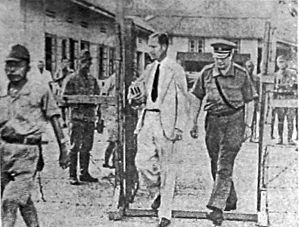
When World War II started in Europe, people expected Japan to invade the Dutch East Indies. The Dutch government, which had limited military training for Indonesians, began teaching people how to prepare for air raids. Sudirman, who was respected in Cilacap, was asked to lead the local Air Raid Preparation team. He taught citizens safety procedures and set up watchposts.
In early 1942, Japan took over the Indies. This brought big changes and made life difficult for many non-Japanese people. Sudirman's school in Cilacap was closed and turned into a military outpost. He convinced the Japanese to reopen it, but supplies were poor. Sudirman also joined social groups, which made him even more recognized in Cilacap.
Joining PETA: Defenders of the Homeland
In early 1944, Sudirman was asked to join the Defenders of the Homeland (PETA). The Japanese government had created PETA in October 1943 to help defend against any Allied invasion. They wanted to recruit younger men who hadn't been "influenced" by Dutch rule.
After some thought, Sudirman agreed to train in Bogor. Because of his standing in the community, he was made a commander (daidanco). He trained with other high-ranking people. They were trained by Japanese officers and used confiscated Dutch weapons. After four months, Sudirman was put in charge of a battalion in Kroya, Banyumas, near Cilacap.
Sudirman's time as a PETA commander was mostly quiet until 21 April 1945. PETA troops, led by Kusaeri, rebelled against the Japanese. Sudirman was ordered to stop the rebellion. He agreed, but only if the rebels would not be harmed and their hiding places would not be destroyed. The Japanese commander agreed.
Sudirman used a loudspeaker to tell Kusaeri's men they would not be harmed. They backed down, and Kusaeri surrendered on 25 April. This gained Sudirman support from the Japanese, though some officers worried about his support for Indonesian independence. Sudirman and his men were later sent to a camp in Bogor, supposedly for training. However, they were forced to do hard labor, and there were rumors they would be killed.
Leading the Revolution
Becoming Commander of the Armed Forces
In August 1945, news of the atomic bombings of Hiroshima and Nagasaki reached Indonesia. It was clear that Japanese control was ending. Indonesia declared independence on 17 August. Sudirman led a breakout from the camp in Bogor. He convinced his fellow prisoners not to attack the Japanese soldiers. He then went to Jakarta to meet President Sukarno. Sukarno asked him to lead resistance against Japanese forces in Jakarta, but Sudirman preferred to lead forces in Kroya. He left for Kroya on 19 August 1945. At the same time, Allied forces were returning to Indonesia to help the Dutch regain control.
In late August, Sukarno created the People's Safety Bureau (BKR). This group brought together former PETA, Heiho, and KNIL troops. The BKR mostly acted like a police force. Sudirman and other PETA soldiers formed a BKR branch in Banyumas. They forced the Japanese commander to surrender and hand over weapons. Many of these weapons were used by Sudirman's BKR unit, making it one of the best-equipped in the country.
Since Indonesia didn't have a professional army yet, Sukarno created the People's Security Armed Forces (TKR) on 5 October 1945. Most officers were former Dutch-trained soldiers, while regular soldiers were from PETA and Heiho. The chosen Commander of the Armed Forces, Soeprijadi, didn't appear. So, Lieutenant General Oerip Soemohardjo became the temporary leader.
In October, British-led forces arrived in Semarang and moved south to Magelang. When the British started rearming Dutch prisoners, Sudirman, now a colonel, sent his troops to push them back. The mission worked, and the European soldiers moved to Ambarawa. On 20 October, Sudirman was put in command of the Fifth Division.
On 12 November 1945, at the first meeting of Army leaders, Sudirman was elected Commander of the Armed Forces (Panglima Besar). He was 29 years old and surprised by his selection. He offered the position to Oerip, but the meeting didn't allow it. Sudirman kept Oerip as his chief of staff. Sudirman was promoted to general.
The Battle of Ambarawa
While waiting for his appointment to be confirmed, Sudirman ordered the Fifth Division to attack Allied forces in Ambarawa in late November. The city was important because of its military barracks. The Allied forces fought back with air strikes and tanks, forcing Sudirman's division to retreat. Sudirman then led another attack. Indonesian troops used bamboo spears and captured swords, while the British had modern weapons. Sudirman led from the front, carrying a sword.
The Allies' air support was cut off when Indonesian soldiers attacked an airfield. They were forced to hide in Willem Fortress. On 12 December, Sudirman led a four-day siege. This forced the Allied forces to withdraw to Semarang.
The Battle of Ambarawa made Sudirman famous across the country. It stopped people from saying he wasn't fit to lead because he used to be a schoolteacher. Sudirman was chosen because his loyalty was clear, unlike Oerip, who had served the Dutch. Sudirman was confirmed as commander of the Armed Forces on 18 December 1945. He then focused on bigger military strategies. Oerip handled many of the daily military tasks.
Together, Sudirman and Oerip helped unite former Dutch-trained and PETA troops. The government renamed the Army twice in January 1946. A navy and air force were also officially created. In January, the Indonesian government moved from Jakarta to Yogyakarta. On 25 May, Sudirman was reconfirmed as commander of the expanded military. He swore to protect the republic "until he shed his last drop of blood."
The Minister of Defence, Amir Sjarifuddin, started gathering socialist and communist troops under his control. This use of the military for political reasons disappointed Sudirman and Oerip. Rumors spread that Sudirman was planning a coup d'état. In July, Sudirman spoke on Radio Republik Indonesia (RRI), saying he was a servant of the State and would refuse the presidency if offered. He later said the military should not be involved in politics.
Negotiations and Fighting the Dutch
Meanwhile, Prime Minister Sutan Sjahrir continued talks with Allied forces. On 7 October 1946, Sjahrir and the Dutch Prime Minister agreed to work towards a ceasefire. Sudirman was part of these discussions. He traveled to Jakarta, but ordered his train to return to Yogyakarta when Dutch troops wouldn't let his men enter with their weapons. The Dutch apologized, and Sudirman arrived in Jakarta on 1 November.
The talks led to the Linggadjati Agreement on 15 November. Sudirman was against this agreement, believing it hurt Indonesia. But he felt he had to follow orders.
In early 1947, Sudirman worked to combine the TKR with various local armed groups (laskar). On 3 June 1947, the Indonesian National Armed Forces (TNI) was officially formed. However, the ceasefire from the Linggadjati Agreement didn't last. On 21 July 1947, Dutch forces launched Operation Product, quickly taking over large parts of Java and Sumatra. Sudirman urged the army to fight, but Indonesian soldiers were not ready and quickly lost ground.
Under pressure from the United Nations, the Dutch created the Van Mook Line on 29 August 1947. This line divided Dutch and Indonesian-controlled areas. A ceasefire was called along this line. Sudirman ordered Indonesian guerrillas hiding in Dutch areas to return to Indonesian-held lands. He called this withdrawal a hijrah, like Muhammad's migration to Medina, suggesting they would return. Over 35,000 troops left western Java and traveled to Yogyakarta.
This boundary was made official by the Renville Agreement on 17 January 1948. Sudirman was no longer commander-in-chief of the military starting on 2 January 1948. He was demoted to lieutenant general. Soon after, Prime Minister Sjarifuddin was removed from power for his role in the Renville Agreement. The new prime minister, Mohammad Hatta, worked to reduce the size of the army. Sudirman became a leader for soldiers who were against this plan. Sudirman was formally put back in charge on 1 June 1946. He chose Colonel Abdul Haris Nasution as his deputy.
As the army was being reorganized, Sjarifuddin started gathering soldiers for a revolution in Madiun, East Java, on 18 September 1948. Sudirman, who was sick, sent Nasution to deal with the revolution. Nasution and his soldiers stopped the uprising by 30 September. Sudirman visited Madiun after the battle and was saddened by the bloodshed.
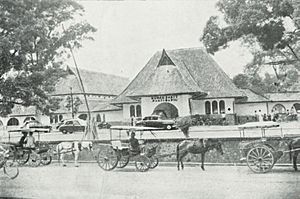
This rebellion and political problems weakened Sudirman. On 5 October 1948, he collapsed. Doctors diagnosed him with tuberculosis. In late October, he went to Panti Rapih Hospital and had his right lung collapsed to stop the disease from spreading. During his time in the hospital, he gave most of his duties to Nasution. But they still planned for the war against the Dutch. They agreed that guerrilla warfare would be best. Sudirman was released from the hospital on 28 November 1948.
He returned to duty on 17 December. He ordered TNI soldiers to be ready for an attack. Two days later, on 19 December, the Dutch launched Operation Kraai to capture Yogyakarta. Sudirman heard about the attack and ordered soldiers to fight as guerrillas.
No. 1/PB/D/48
- We have been attacked.
- On 19 December 1948 the Dutch Military attacked the city of Yogyakarta and the Maguwo airfield.
- The Dutch government has negated the Ceasefire.
- All soldiers are to deal with the Dutch attack as previously agreed.
He went to the Presidential Palace, where leaders were discussing surrendering to the Dutch. Sudirman urged the president and vice-president to leave the city and fight as guerrillas, but they refused. Although his doctors said no, Sudirman got permission from Sukarno to join his men. The government leaders were captured and sent away.
Leading Guerrilla Warfare
Sudirman first went home to burn important documents so the Dutch wouldn't get them. His group, including soldiers and his doctor, went south. They stayed in Kretek for a few days. Sudirman sent soldiers into the Dutch-occupied city to gather information and ask his wife for jewelry to fund the guerrilla movement. Then, they traveled east along the south coast. Before the Dutch attack, it was decided that Sudirman could better control the guerrillas from eastern Java, where there were still bases. His wife and children were told to stay in the Kraton.
Sudirman knew the Dutch were chasing him. On 23 December, he ordered his troops to continue to Ponorogo. They stopped at the home of Mahfuz, an Islamic religious leader. Mahfuz gave the general a cane, but Sudirman was often carried on a litter because of his illness. They continued east.
Outside Trenggalek, Sudirman's group was stopped by TNI soldiers. These soldiers didn't recognize Sudirman, who was in civilian clothes. They thought he was a prisoner. When their commander, Major Zainal Fanani, arrived, he realized it was Sudirman and apologized. Sudirman told him his men were right to guard their areas well.
The constant Dutch attacks led Sudirman to change his clothes and give his old uniform to a soldier who looked like him. This soldier was ordered to go south with a large group of soldiers to create a diversion. Sudirman waited in Karangnongko. The trick worked. On 27 December, Sudirman and his men went to Jambu Village. On 9 January 1949, Sudirman met with government ministers who had not been captured. They traveled to Banyutuwo, where they stayed for over a week. But on 21 January, Dutch forces approached, and Sudirman's group had to fight their way out in heavy rain.
Sudirman and his troops continued through jungles and forests. They arrived at Sobo, near Mount Lawu, on 18 February. During the journey, Sudirman used a radio to send orders to local TNI troops. He felt weaker from the travel and lack of food. He decided Sobo would be his guerrilla headquarters. The local commander, Lieutenant Colonel Wiliater Hutagalung, helped him communicate with other TNI leaders.
Sudirman and Hutagalung discussed a large-scale attack. They knew that international opinion was turning against the Dutch. Sudirman ordered Hutagalung to plan an attack where TNI soldiers, in uniform, would show their strength to foreign reporters. This led to the General Offensive of 1 March 1949. TNI soldiers attacked Dutch outposts across central Java. Troops under Lieutenant Colonel Suharto even retook Yogyakarta for six hours. This was a successful show of force that made the Dutch look bad internationally.

Under pressure from the United Nations, Dutch–Indonesian talks led to the Roem–Van Roijen Agreement on 7 May 1949. This agreement promised Dutch withdrawal from Yogyakarta. The Dutch began leaving in late June. Indonesian leaders started returning to Yogyakarta in early July. Sukarno ordered Sudirman to return, but Sudirman refused. He believed the TNI was strong enough to defeat the Dutch. He only agreed to return after receiving a letter. On 10 July, Sudirman and his group returned to Yogyakarta. Thousands of civilians and political leaders welcomed them.
Later Life and Passing
In early August, Sudirman asked Sukarno to continue the guerrilla war. He didn't trust the Dutch to keep their promises. Sukarno disagreed, which upset Sudirman. When Sudirman threatened to resign, Sukarno threatened to resign too. Sudirman decided to stay, and a ceasefire across Java began on 11 August 1949.
Sudirman continued to suffer from tuberculosis. He stayed in Panti Rapih hospital until October, then moved to a sanatorium. Because of his illness, he made few public appearances. In December, Sudirman moved to a home in Magelang. Meanwhile, the Indonesian and Dutch governments held a conference. This led to Dutch recognition of Indonesian independence on 27 December 1949. Sudirman, despite his illness, was reconfirmed as commander-in-chief of the TNI. On 28 December, Jakarta became the nation's capital again.
Sudirman died in Magelang at 6:30 PM on 29 January 1950. His death was announced on RRI. Many visitors came to his family home. The next morning, Sudirman's body was brought to Yogyakarta. Thousands of mourners stood along the streets as the funeral procession passed.
The viewing was held at the Great Mosque of Yogyakarta. Many important people from Indonesia and other countries attended. The viewing ended with a 24-gun salute. Sudirman's body was carried on foot to Semaki Heroes' Cemetery. A crowd of mourners, 2 kilometers long, followed behind. He was buried next to Oerip, after another gun salute. His wife placed the first scoop of dirt, followed by government ministers. The government ordered flags to be flown at half-mast across the country. Sudirman was promoted to full general. Major-General Tahi Bonar Simatupang became the new leader of the armed forces. Sudirman's memoirs were published later that year.
Sudirman's Lasting Legacy
An obituary in the Yogyakarta newspaper Kedaulatan Rakjat said Indonesia had lost a "brave and true hero." Colonel Paku Alam VIII said all Indonesians, especially the armed forces, had "lost a father figure who did uncountable deeds for his country." The Indonesian Muslim leader Haji Abdul Malik Karim Amrullah called Sudirman a "symbol of the strength of spirit shown by Indonesian heroes." The Muslim politician Muhammad Isa Anshary described Sudirman as a "son of the revolution."
Mohammad Hatta said Sudirman was hard to control but always wanted to do what was right for the country. He noted that Sudirman often disagreed with the government but usually obeyed orders. However, some Dutch-trained soldiers were disappointed in Sudirman because of his background and less military experience.
Today, Sudirman is highly praised in Indonesia. Historian Sardiman says Sudirman was a lively speaker and a dedicated, honest leader. Historian Nugroho Notosusanto called Sudirman "his only idol," saying the general's guerrilla period created the army's strong team spirit. Since the 1970s, all military students must retrace Sudirman's 100-kilometer route before graduating. This "pilgrimage" helps them feel the struggle he went through. Sudirman's grave is also a place where military personnel and the public visit to honor him.
Sudirman received many awards from the government after his death. On 10 December 1964, he was declared a National Hero of Indonesia. He was promoted to General of the Army in 1997.
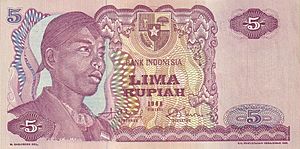
The Indonesian military has used Sudirman's image as a symbol of leadership. His picture was on every denomination of the 1968 series of rupiah banknotes. He was also a main character in several war films, like Janur Kuning (1979) and Serangan Fajar (1982).
Many museums are dedicated to Sudirman. His childhood home in Purbalingga is now the Sudirman Museum. His official home in Yogyakarta is now the Sasmitaloka Museum to General Sudirman. The house in Magelang where he died is also a museum, containing his belongings. Other museums, like the Monument Yogya Kembali in Yogyakarta and the Satriamandala Museum in Jakarta, have rooms dedicated to him.
Many streets are named after Sudirman, including a major street in Jakarta. Almost every city in Indonesia has a General Sudirman Street. Statues and monuments of him are found throughout the country. Jenderal Sudirman University in Banyumas, founded in 1963, is also named after him.


